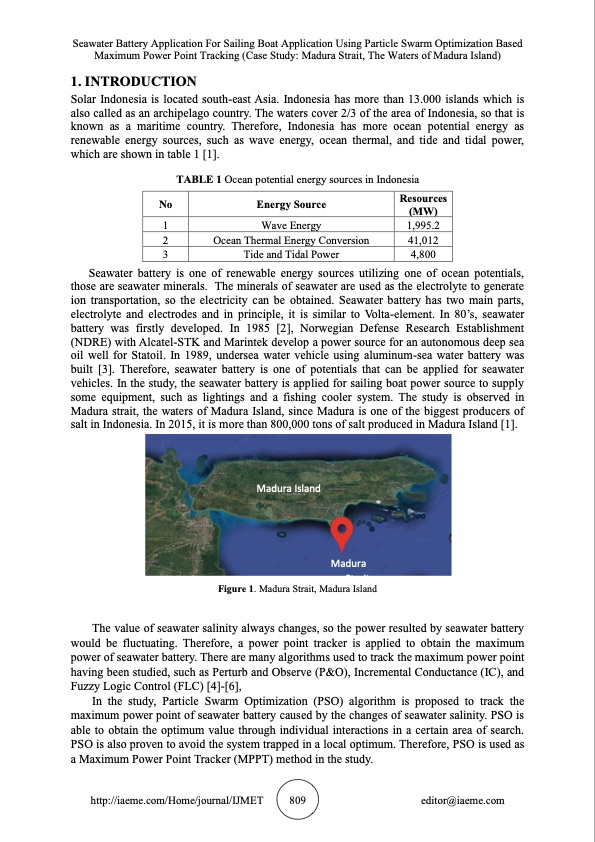
PDF Publication Title:
Text from PDF Page: 002
Seawater Battery Application For Sailing Boat Application Using Particle Swarm Optimization Based Maximum Power Point Tracking (Case Study: Madura Strait, The Waters of Madura Island) 1. INTRODUCTION Solar Indonesia is located south-east Asia. Indonesia has more than 13.000 islands which is also called as an archipelago country. The waters cover 2/3 of the area of Indonesia, so that is known as a maritime country. Therefore, Indonesia has more ocean potential energy as renewable energy sources, such as wave energy, ocean thermal, and tide and tidal power, which are shown in table 1 [1]. No 1 2 3 Energy Source Wave Energy Ocean Thermal Energy Conversion Tide and Tidal Power Resources (MW) 1,995.2 41,012 4,800 TABLE 1 Ocean potential energy sources in Indonesia Seawater battery is one of renewable energy sources utilizing one of ocean potentials, those are seawater minerals. The minerals of seawater are used as the electrolyte to generate ion transportation, so the electricity can be obtained. Seawater battery has two main parts, electrolyte and electrodes and in principle, it is similar to Volta-element. In 80’s, seawater battery was firstly developed. In 1985 [2], Norwegian Defense Research Establishment (NDRE) with Alcatel-STK and Marintek develop a power source for an autonomous deep sea oil well for Statoil. In 1989, undersea water vehicle using aluminum-sea water battery was built [3]. Therefore, seawater battery is one of potentials that can be applied for seawater vehicles. In the study, the seawater battery is applied for sailing boat power source to supply some equipment, such as lightings and a fishing cooler system. The study is observed in Madura strait, the waters of Madura Island, since Madura is one of the biggest producers of salt in Indonesia. In 2015, it is more than 800,000 tons of salt produced in Madura Island [1]. The value of seawater salinity always changes, so the power resulted by seawater battery would be fluctuating. Therefore, a power point tracker is applied to obtain the maximum power of seawater battery. There are many algorithms used to track the maximum power point having been studied, such as Perturb and Observe (P&O), Incremental Conductance (IC), and Fuzzy Logic Control (FLC) [4]-[6], In the study, Particle Swarm Optimization (PSO) algorithm is proposed to track the maximum power point of seawater battery caused by the changes of seawater salinity. PSO is able to obtain the optimum value through individual interactions in a certain area of search. PSO is also proven to avoid the system trapped in a local optimum. Therefore, PSO is used as a Maximum Power Point Tracker (MPPT) method in the study. Madura Island Madura Strait Figure 1. Madura Strait, Madura Island http://iaeme.com/Home/journal/IJMET 809 editor@iaeme.comPDF Image | SEAWATER BATTERY APPLICATION FOR SAILING BOAT

PDF Search Title:
SEAWATER BATTERY APPLICATION FOR SAILING BOATOriginal File Name Searched:
IJMET_10_01_083.pdfDIY PDF Search: Google It | Yahoo | Bing
Product and Development Focus for Salgenx
Redox Flow Battery Technology: With the advent of the new USA tax credits for producing and selling batteries ($35/kW) we are focussing on a simple flow battery using shipping containers as the modular electrolyte storage units with tax credits up to $140,000 per system. Our main focus is on the salt battery. This battery can be used for both thermal and electrical storage applications. We call it the Cogeneration Battery or Cogen Battery. One project is converting salt (brine) based water conditioners to simultaneously produce power. In addition, there are many opportunities to extract Lithium from brine (salt lakes, groundwater, and producer water).Salt water or brine are huge sources for lithium. Most of the worlds lithium is acquired from a brine source. It's even in seawater in a low concentration. Brine is also a byproduct of huge powerplants, which can now use that as an electrolyte and a huge flow battery (which allows storage at the source).We welcome any business and equipment inquiries, as well as licensing our flow battery manufacturing.| CONTACT TEL: 608-238-6001 Email: greg@salgenx.com | RSS | AMP |